Mars Exploration Digest: Issue May 2023
A regular monthly digest of Mars research news for May 2023. PDF: Issue 8, Volume 2, ISSN 2788-225X.
Tip:
[SK] Slovenskú verziu článku si môžte prečítať tu: Výber z výskumu Marsu: Máj 2023
 Dear friends, colleagues, and readers. Welcome to the May edition of the MXD journal (Mars Exploration Digest). In this edition, we will again look at the news of Mars’s robotic exploration, as always of course. Maybe you have noted the information boom regarding artificial intelligence (AI) in the news. People are scared, of course, but let’s be focused on the benefits of artificial intelligence and machine learning. We should remember that technology is here for us and we should use it for exploration of other planets and space. One of the best examples of the use of artificial intelligence is the exploration and research of the planet Mars. The best example is the rover Perseverance, the most advanced robot that is currently working on Mars. Let’s take a look at the latest news that I have summarized in this edition of MXD.
Dear friends, colleagues, and readers. Welcome to the May edition of the MXD journal (Mars Exploration Digest). In this edition, we will again look at the news of Mars’s robotic exploration, as always of course. Maybe you have noted the information boom regarding artificial intelligence (AI) in the news. People are scared, of course, but let’s be focused on the benefits of artificial intelligence and machine learning. We should remember that technology is here for us and we should use it for exploration of other planets and space. One of the best examples of the use of artificial intelligence is the exploration and research of the planet Mars. The best example is the rover Perseverance, the most advanced robot that is currently working on Mars. Let’s take a look at the latest news that I have summarized in this edition of MXD.
Mars Exploration Digest – May 2023
Let’s discover what is new in the Mars exploration for the latest month.
Perseverance and Belva Crater
NASA’s Perseverance rover captured a spectacular view of Belva Crater.
The Mastcam-Z instrument aboard Perseverance recently collected 152 images looking deep into Belva Crater, a large impact crater within the much larger Jezero Crater. The results, which are combined into a dramatic mosaic, are not only eye-catching but also provide the rover’s science team with a deep look into the interior of the Lake.
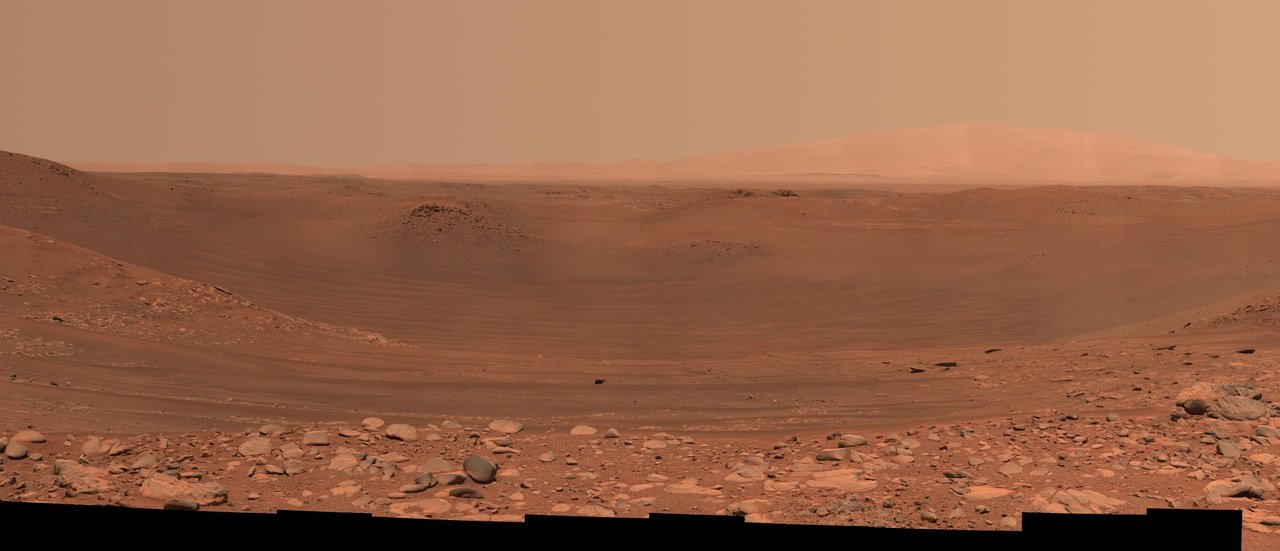
Belva crater on Mars. Image credit: NASA/JPL-Caltech/ASU/MSSS.
The Perseverance rover captured images of the site on April 22 (the 772nd Martian day, or mission Sol), when it was just west of Belva Crater’s rim on a light-colored rocky outcrop that the mission team calls “Echo Creek.” The approximately 0.9 kilometer-wide crater, which was created by the impact of the meteorite, exposes several places of bedrock, as well as an area where the sedimentary layers slope steeply downward. You can find a high-resolution image of the Belva crater at this link. [1]
InSight: Watch archived LIVE stream
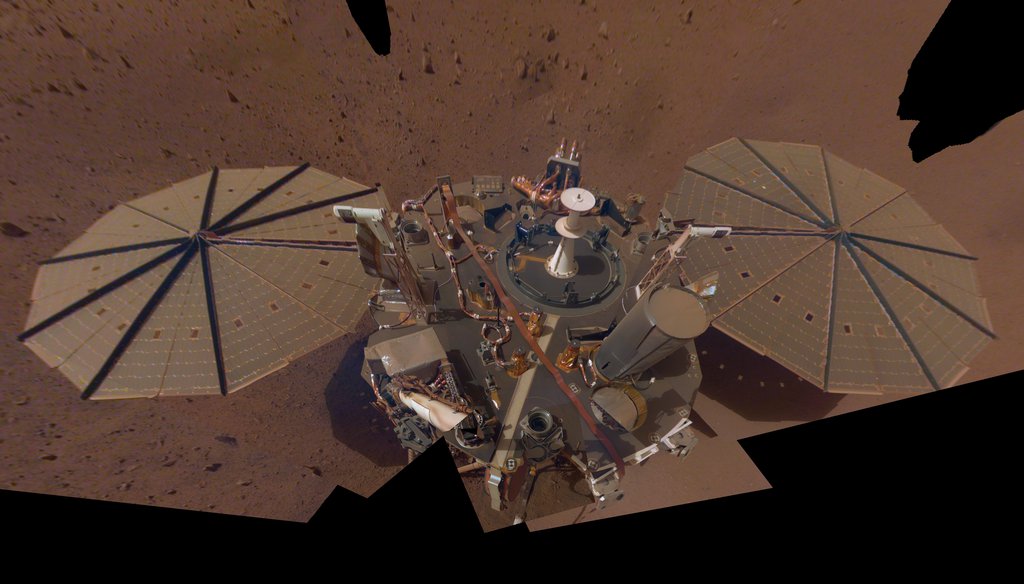
InSight on Mars. Image credit: NASA/JPL-Caltech.
The InSight mission to Mars began its journey to the red planet in May 2018. After arriving in November of the same year, InSight began an ambitious mission to reveal the internal structure of Mars. The lander recorded more than 1,000 seismic events on Mars, studied Martian weather and even found magnetic “ghosts” from an old electric field. The mission ended 4 years after it began when the solar panels succumbed to dust deposition that prevented them from producing power. You can find a recording of the LIVE broadcast here.
InSight: Details about the core of Mars
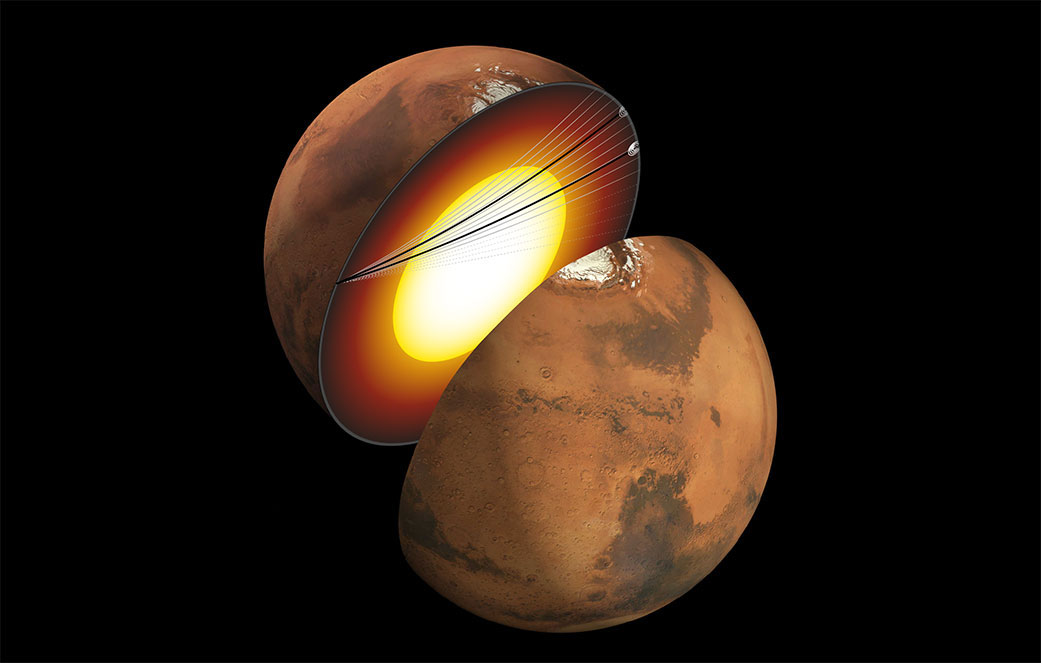
The image shows a slice of Mars along with seismic wave paths from two separate Martian quakes recorded in 2021. Image credit: NASA/JPL-Caltech/University of Maryland.
While NASA retired its InSight Mars probe from the active mission program in December, a wealth of data from its seismometer will be scrutinized for decades to come. By looking at seismic waves detected by the instrument from a pair of shocks in 2021, scientists were able to infer that Mars’ liquid iron core is smaller and denser than previously thought.
The findings, which represent the first direct observations of the core of another planet, were detailed in a paper published April 24 in the Proceedings of the National Academy of Sciences. These two tremors, recorded on August 25 and September 18, 2021, were the first identified by the InSight team that occurred on the opposite side of the planet from the probe itself – so-called far-side marsquakes. Distance proved to be key: the further away from InSight a Martian quake occurred, the deeper into the planet its seismic waves could travel before being detectable. [2]
NASA Curiosity: Important software update
NASA’s Curiosity rover will run faster and reduce wear and tear on its wheels thanks to two new features that are part of a major software update completed on April 7. The two updates are part of a package of up to 160 updates that have been remotely installed on Curiosity’s main on-board computer.
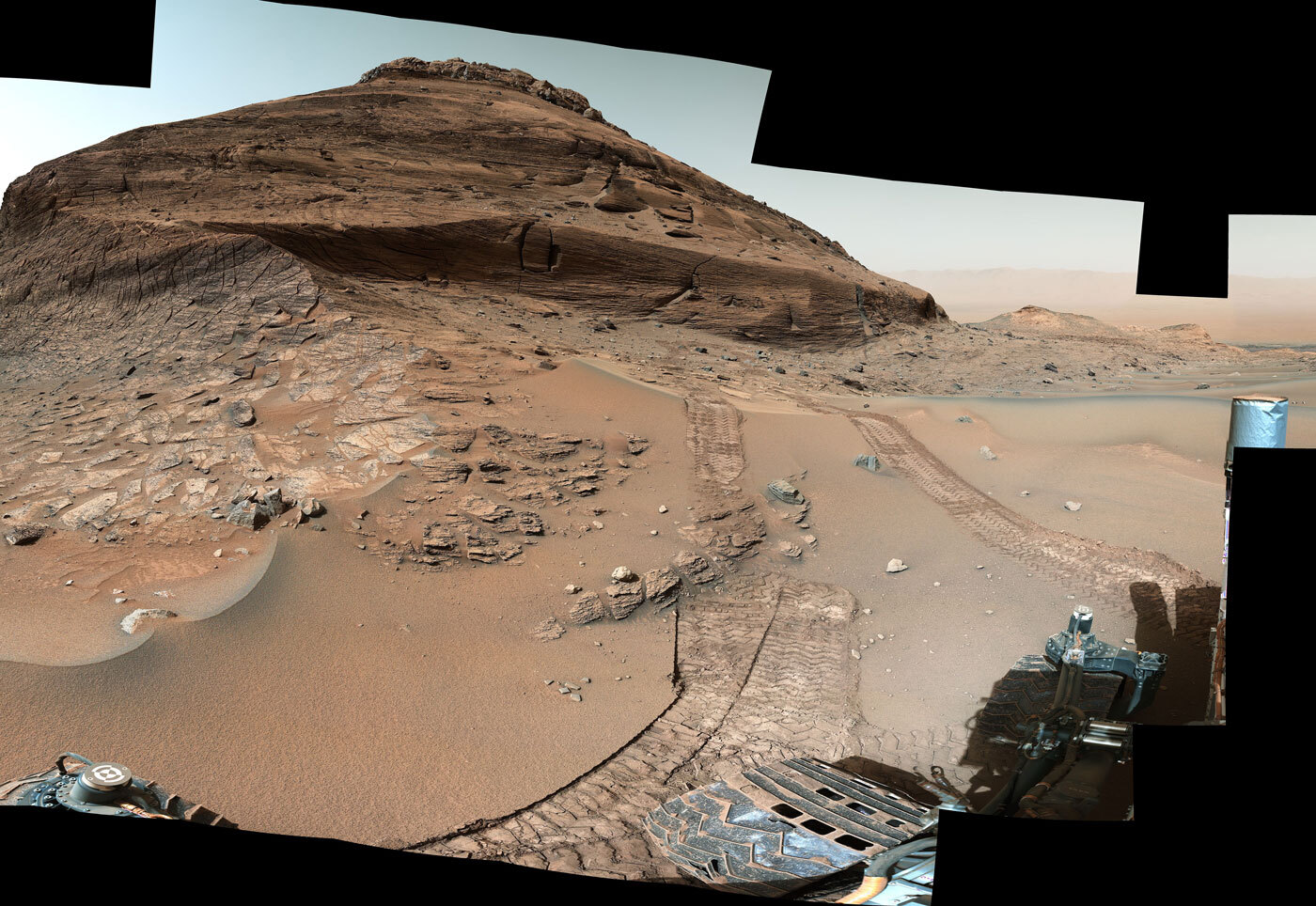
Curiosity and its image of Bolivar Hill. The vast plain of Gale Crater can be seen to the right. Image credit: NASA/JPL-Caltech.
Planning for this major update goes back to 2016 when Curiosity last underwent a software overhaul. Some of the changes this time around are as small as making corrections to the messages the rover sends back to mission controllers on Earth. Others simplify computer code that has been changed in multiple patches since Curiosity landed in 2012. The biggest changes will help keep Curiosity more efficient for years to come.
The rover can now do more of what the team calls “thinking while driving” — something that NASA’s latest Mars probe, Perseverance, can do in a more advanced way when navigating around rocks and sand traps. During its movement on the surface of Mars, Perseverance constantly takes pictures of the terrain in front of it and processes the acquired images with the help of a special computer, so that it can navigate autonomously during one continuous drive.
Curiosity does not have a dedicated computer for this purpose. Instead, it drives in so-called segments and after each segment, it processes the acquired images of the surrounding terrain. This means that it has to start and stop repeatedly during a long drive. The new software will help the Curiosity rover process images faster, allowing it to spend more time roaming the surface of Mars. [3]
The possibility of contributing to the monthly magazine about Mars
Are you looking for a professional journal or magazine where you could publish your text, research, or scientific-popular article? Do you like planets and space? Are you a student, researcher, astronomer, teacher, or space enthusiast? Here is a unique opportunity for you to publish your text in a new professional periodical.
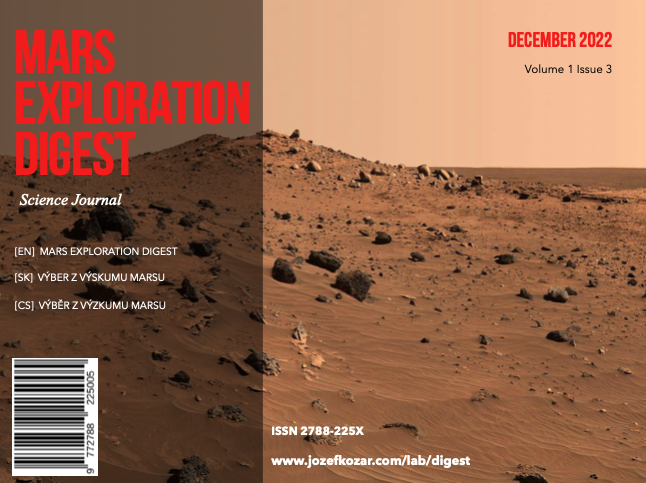
The cover of the January 2023 edition. Image credit: Jozef Kozar, Ph.D.
Use this opportunity to publish in the new magazine “Mars Exploration Digest” (abbreviation “MXD”). This new monthly magazine is starting its second year. It is available to everyone for free (open access). It is published in PDF format in two languages – English and Slovak (posts in Czech are also welcome).
The focus of this monthly magazine is not commercial. Its goal is not only to provide information from the world of Mars exploration but also to help in education and publishing new knowledge.
And a bonus for you? You can contribute your text for free. You can use this published article as a reference in your list of publications because Mars Exploration Digest is a professional journal. The readership of this magazine is growing rapidly, as it is a very specific periodical. So don’t hesitate and take your chance now. Mars Exploration Digest is registered under ISSN 2788-225X by the Czech National Technical Library in Prague (The Czech Republic, EU).
~ Jozef Kozár, PhD.
PDF: Issue 8, Volume 2, ISSN 2788-225X.
Sources:
[1] NASA’s Perseverance Rover Captures View of Mars’ Belva Crater. May 18, 2023; NASA Jet Propulsion Laboratory, Pasadena, California.
[2] NASA InSight Study Provides Clearest Look Ever at Martian Core – NASA Mars Exploration. NASA Mars Exploration [online]: https://mars.nasa.gov/news/9387/nasa-insight-study-provides-clearest-look-ever-at-martian-core/
[3] NASA’s Curiosity Mars Rover Gets a Major Software Upgrade – NASA Mars Exploration. NASA Mars Exploration [online]: https://mars.nasa.gov/news/9378/nasas-curiosity-mars-rover-gets-a-major-software-upgrade/
Tip:
[SK] Slovenskú verziu článku si môžte prečítať tu: Výber z výskumu Marsu: Máj 2023
You can download this issue for free here:
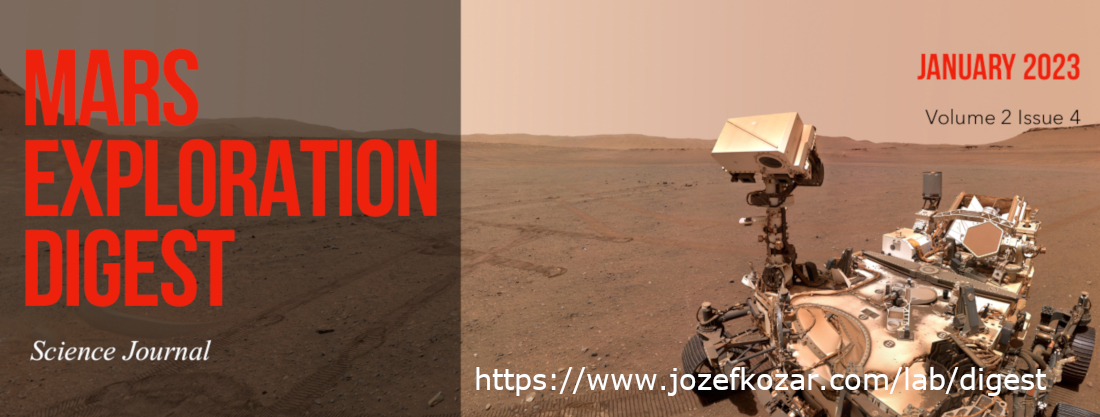
May 2023
Send download link to:


